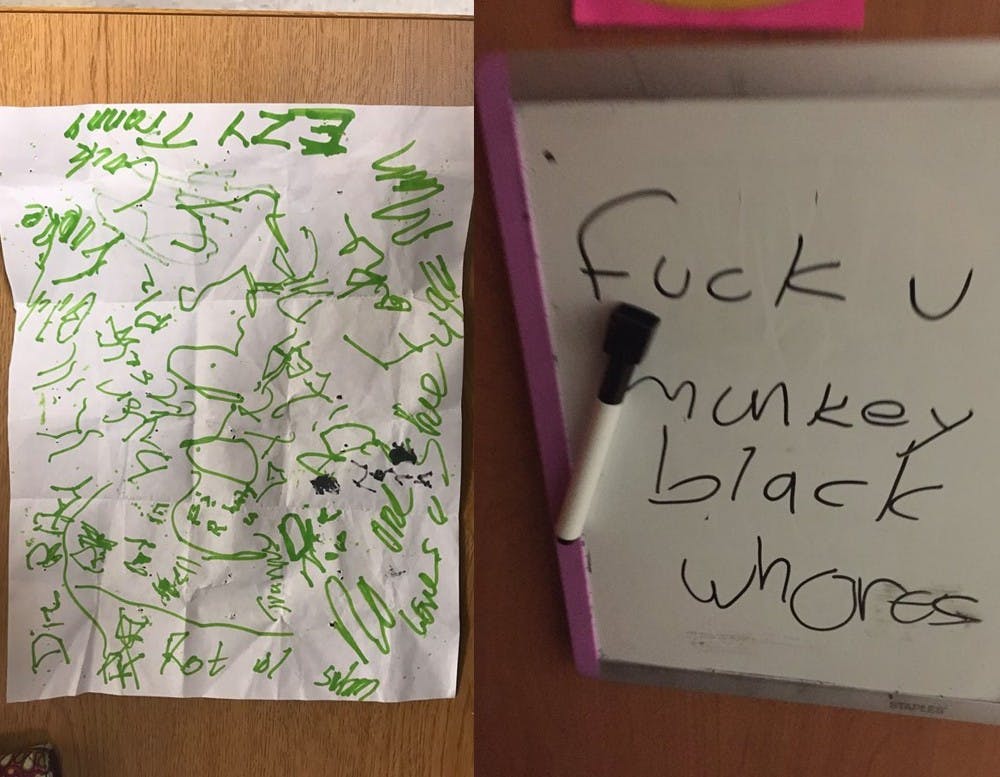CMU students and community members reflect on bias incident prevalence, university responses

Courtesy Photos | Facebook
Left: Transphobic message left in an installation created by Resident Assistant Jace Parker for his residents Dec. 8 in Robinson Hall.
Right: Racist message left on Detroit sophomore Yasmeen Duncan's dorm room Nov. 7 in Sweeney Hall.
Four days after sophomore and Robinson Residence Hall Assistant Jace Parker received a transphobic note on his whiteboard Nov. 20, he received a threatening note in an installation he created for his residents.
Though this was the second incident Parker experienced within a week, swelling concerns over noncriminal bias incidents and related issues happen far beyond Central Michigan University.
According to the FBI, hate crime reports have risen 17 percent from 2016 to 2017. Reported hate crimes in Michigan increased from 309 in 2015 to 456 in 2017. Hate crimes are also increasing on college campuses. With a string of reported bias incidents at CMU and a nationwide trend in hate crimes, CMU community members are grappling with how to prevent more damage from hate.
The Office of Civil Rights and Institutional Equity doesn’t provide reports on frequency of complaints, which would include noncriminal bias incidents. No hate crimes were reported to the CMU Police Department between 2015 and 2017, according to the 2018 annual report.
Skyler Everette, a Holland transgender graduate student, has experienced bathroom harassment at CMU more times than they can count — being called slurs like “dyke,” “tranny” and “fag” and feeling unsure whether it would escalate to physical violence.
Everette — who didn’t report these incidents — suspects bias incidents are under-reported at CMU, noting other members of Transcend, a Registered Student Organization for transgender students, have had similar experiences.
“This absolutely happens all the time,” Everette said.
CMU NAACP President Australyah Coleman, a Grand Rapids junior, said bias incidents are “very common” but students can feel afraid they won’t be taken seriously if they report.
“(Bias incidents are) constantly pushed under the rug,” Coleman said. "Nobody ever says anything."
Still, Coleman said there have been positives in her experiences with CMU after the Sweeney Hall incident.
The CMU NAACP, Black Student Union and Collective Action for Cultural Unity presidents have been in contact with university officials including A.T. Miller, Jonathan Glenn and Anthony Voisin following the Sweeney incident. Coleman has also been in contact with President Davies, who she says has taken her concerns very seriously.
Similarly, Parker’s public Facebook post about the first incident thanked the “amazing” Residence Life staff for their action.
But the post also noted he had given CMU 11 days to make the incident public.
“CMU as a whole has not brought attention to the incident at hand,” Parker wrote. “So I will take it into my own hands.”
A later Facebook post from Parker thanked the university and CMU Police Department for their ongoing investigations. The post thanked CMU for helping him attain a new ID with his preferred rather than legal name.
“I can't thank CMU enough for all the support they have shown and the positive action that have been done,” Parker wrote. “There is nothing but support coming my way.”
Some students and community members are advocating changes to how the university prevents and responds to such incidents.
One consideration that has garnered discussion on social media is the installment of security cameras in the hallways of residence halls.
Some argue it would be too much surveillance, while others like Coleman and Everette argue it increases safety without infringing on privacy.
“It is a communal space and in many other communal spaces we have cameras,” Everette said.
Security camera installment is being considered by CMU administration, Chief Diversity Officer and Vice President A.T. Miller said.
Another possible action is banning whiteboards, which Michigan State University did last year.
Whiteboards aren’t as necessary for communication among students in the age of cell phones and social media, Everette said
“Removing whiteboards would be beneficial because clearly this is an easy way for students to be targeted,” Everette said.
Administrators have not yet made a decision on whiteboards, but Miller said whiteboards aren't the problem.
“Without better promotion of CMU values, this stuff will just happen in a different way,” Miller said. “Some jerk will still slip a note under the door.”
For Everette, CMU administrators don’t just need to consider policy — they also need to be mindful of how they communicate about different incidents.
CMU handled the Sweeney and Robinson incidents very differently, Everette said.
With the Sweeney incident, all students received an email from President Davies, but no such email was sent after the Robinson incident.
“(The email) was an explicit ‘you belong here’ from a higher up,” Everette said.
CMU administrators should have a specific protocol for how they communicate following bias incidents, Everette said. They added the protocol could also include guidelines about which offices could offer “safe spaces” to process the events afterward.
Reflecting on the difficult past weeks, Parker said the incident could have happened to someone else, someone who was completely in the closet. Someone like that could end up hurting themselves, he said. He hoped his story could help keep it from happening to someone else.
“I try to find the silver lining in everything,” Parker wrote on Facebook. “The biggest one is, I can say that there is no reason to hide who you truly are and I can help people that may also be a target for hateful words.”






